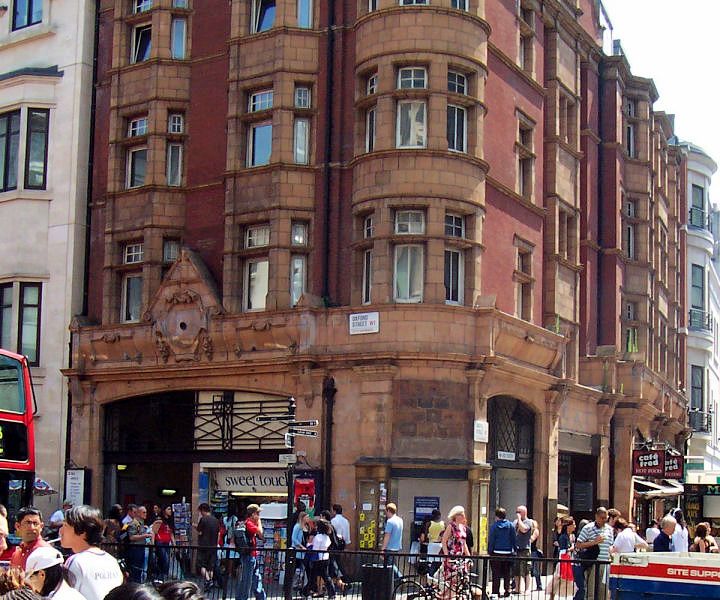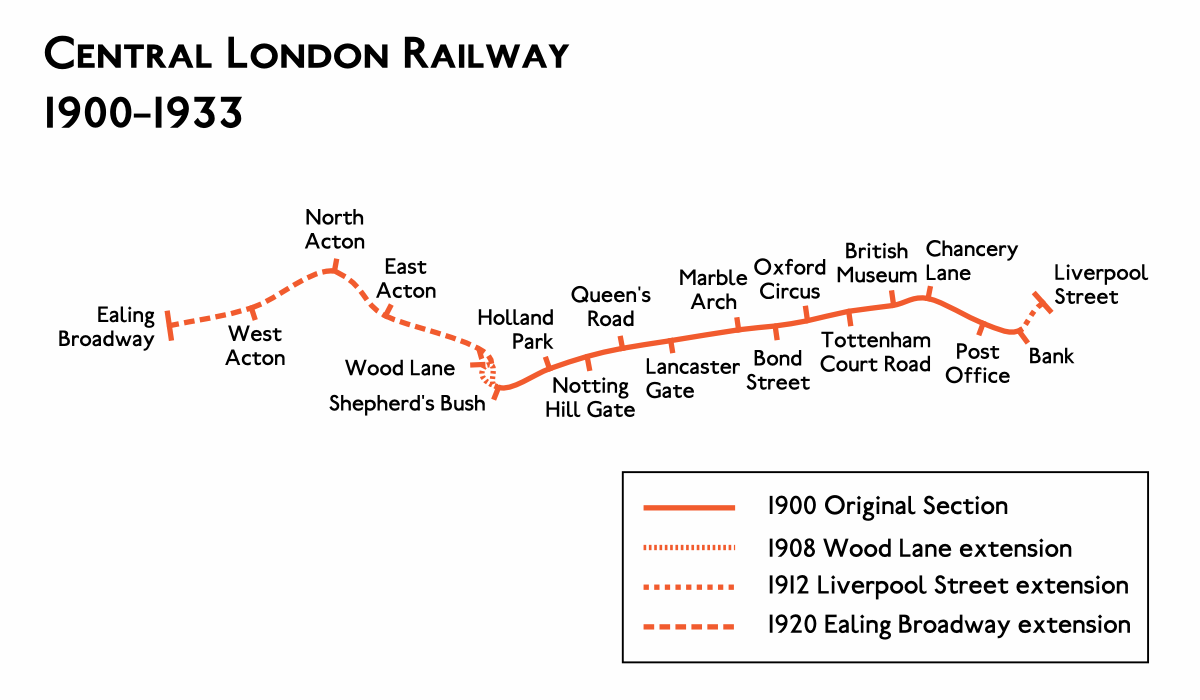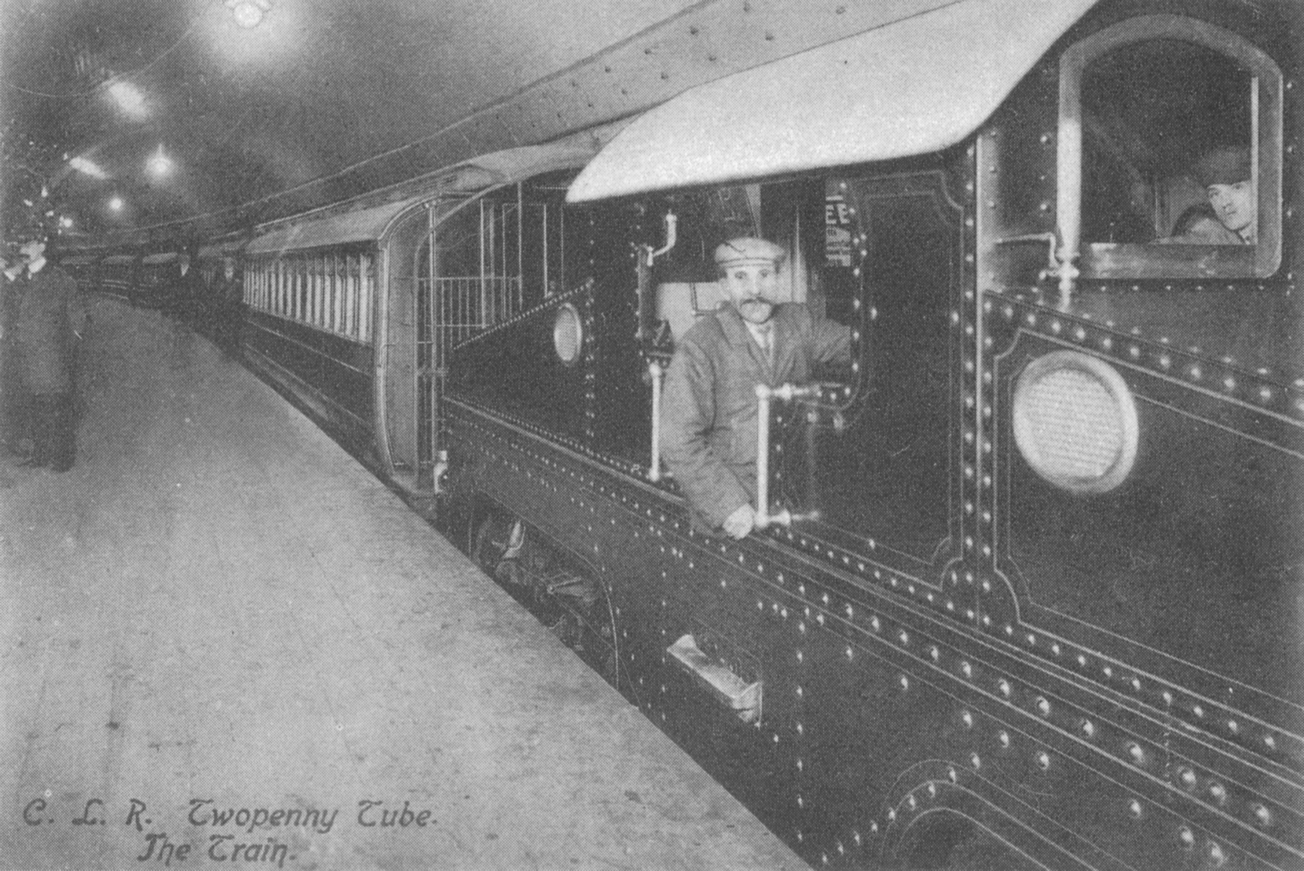|
London Underground 1915 Stock
Twenty-four 1915 Tube Stock driving motor cars were built by Brush for the Central London Railway's extension from Wood Lane to Ealing Broadway. No trailer cars were built as part of the stock. The extension was not completed until 1917 and operation did not start until 1920 so the cars were initially transferred to the Bakerloo tube for use on the Watford extension, for which they were fitted with contact shoes for the 4th rail. Once returned to the Central, cars were not compatible with the 1903 tube stock. Because of this the different stock were given nicknames, the 1915 stock became known as the 'Ealing Stock' while the 1903 stock became known as 'Tunnel Stock' or 'Local Stock'. As no trailer cars had been built several 1900 stock trailers were modified to run with them. External linksLondon Transport Museum Photographic Archive** ** 1915 Events Below, the events of World War I have the "WWI" prefix. January * January – British physicist Sir ... [...More Info...] [...Related Items...] OR: [Wikipedia] [Google] [Baidu] |
Brush Traction
Brush Traction is a manufacturer and maintainer of railway locomotives in Loughborough, England. It is a subsidiary of Wabtec. History Hughes's Locomotive & Tramway Engine Works Henry Hughes had been operating at the Falcon Works since the 1850s, producing items such as brass and iron cast parts for portable engines and thrashing machines. In 1860 Henry Hughes announced he had entered into a partnership with William March who had extensive experience in the timber trade, and this would be added to the existing business of "engineers and manufacturers of railway plant", with the business to be called Hughes and March. In March 1863, Hughes announced it was making a steam locomotive designed for contractors and mineral railways. This was an 0-4-0 saddle tank with a 200 psi boiler pressure and cylinders of 10 inch bore and 15 inch stroke. In 1866, Hughes announced a sale of timber and associated equipment from the "Falcon Railway Plant Works" as he had decided to close down ... [...More Info...] [...Related Items...] OR: [Wikipedia] [Google] [Baidu] |
Central Line (London Underground)
The Central line is a London Underground line that runs through central London, from , Essex, in the north-east to and in west London. Printed in red on the Tube map, the line serves 49 stations over . It is one of only two lines on the Underground network to cross the Greater London boundary, the other being the Metropolitan line. One of London's deep-level railways, Central line trains are smaller than those on British main lines. The line was opened as the Central London Railway in 1900, crossing central London on an east–west axis along the central shopping street of Oxford Street to the financial centre of the City of London. It was later extended to the western suburb of Ealing. In the 1930s, plans were created to expand the route into the new suburbs, taking over steam-hauled outer-suburban routes to the borders of London and beyond to the east. These projects were mostly realised after Second World War, when construction stopped and the unused tunnels were used as air ... [...More Info...] [...Related Items...] OR: [Wikipedia] [Google] [Baidu] |
London Underground Infrastructure
The railway infrastructure of the London Underground includes 11 lines, with 272 stations. There are two types of line on the London Underground: services that run on the sub-surface network just below the surface using larger trains, and the deep-level tube lines, that are mostly self-contained and use smaller trains. Most of the lines emerge on the surface outside the Central London area. The oldest trains currently in service on the Underground are 1972 Stock trains on the Bakerloo line. The Underground is electrified using a four-rail system, the DC traction supply being independent of the running rails. Planned improvements include new stations, line extensions and more lines with automatic train operation (ATO). Railway The total length of railway on the London Underground is and made up of the sub-surface network and the deep-tube lines. In 1971/72 it was re-measured in kilometres using Ongar as the zero point. Sub-surface network and deep-level tube lines The Circl ... [...More Info...] [...Related Items...] OR: [Wikipedia] [Google] [Baidu] |
Central London Railway
The Central London Railway (CLR), also known as the Twopenny Tube, was a deep-level, underground "tube" railwayA "tube" railway is an underground railway constructed in a cylindrical tunnel by the use of a tunnelling shield, usually deep below ground level. Contrast "cut and cover" tunnelling. that opened in London in 1900. The CLR's tunnels and stations form the central section of the London Underground's Central line. The railway company was established in 1889, funding for construction was obtained in 1895 through a syndicate of financiers and work took place from 1896 to 1900. When opened, the CLR served 13 stations and ran completely underground in a pair of tunnels for between its western terminus at Shepherd's Bush and its eastern terminus at the Bank of England, with a depot and power station to the north of the western terminus.Length of line calculated from distances given at After a rejected proposal to turn the line into a loop, it was extended at the western end t ... [...More Info...] [...Related Items...] OR: [Wikipedia] [Google] [Baidu] |
Wood Lane Tube Station
Wood Lane is a London Underground station in the White City area of west London, United Kingdom. It is on the Circle and Hammersmith & City lines, between Latimer Road and Shepherd's Bush Market stations, in Travelcard Zone 2. Although it is on a line which has been in operation since 1864, the station is new, having opened on 12 October 2008 – the first station to be built on an existing Tube line for over 70 years. It is near the site of a station of the same name that closed on 24 October 1959. History The Hammersmith and City line was opened on 13 June 1864 by the Metropolitan Railway (MR) as the Hammersmith branch line. The railway became part of London Underground in 1933 and took on a separate identity as the Hammersmith and City line in 1990. In 1908 the Franco-British Exhibition and the 1908 Summer Olympics came to London, the first of a number of major events in White City that attracted infrastructural investment by railway companies. Among others, the MR open ... [...More Info...] [...Related Items...] OR: [Wikipedia] [Google] [Baidu] |
Ealing Broadway Station
Ealing Broadway is a major single-level interchange station in Ealing in London, England. It is in the London Borough of Ealing, West London, and is served by the London Underground and also National Rail on the Great Western Main Line. On the Underground, it is one of three western termini of the District line, the next station being , and it is also one of two western termini of the Central line, the next station being . On the National Rail network, it is a through-station on the Great Western Main Line, down the line from , between and . The station is managed by Transport for London and is served by Great Western Railway and Elizabeth line services. , the station is being upgraded and expanded as part of the Crossrail project, with a rebuilt ticket hall and the provision of step free access. History The Great Western Railway (GWR) opened its pioneering broad gauge tracks through Ealing Broadway between and on 6 April 1838, although Ealing Broadway station did not o ... [...More Info...] [...Related Items...] OR: [Wikipedia] [Google] [Baidu] |
Baker Street And Waterloo Railway
The Baker Street and Waterloo Railway (BS&WR), also known as the Bakerloo tube, was a railway company established in 1893 that built a deep-level underground "tube" railway in London. The company struggled to fund the work, and construction did not begin until 1898. In 1900, work was hit by the financial collapse of its parent company, the London & Globe Finance Corporation, through the fraud of Whitaker Wright, its main shareholder. In 1902, the BS&WR became a subsidiary of the Underground Electric Railways Company of London (UERL) controlled by American financier Charles Yerkes. The UERL quickly raised the funds, mainly from foreign investors. When first opened in 1906, the BS&WR's line served nine stations and ran completely underground in a pair of tunnels for between its northern terminus at Baker Street and its southern terminus at Elephant and Castle with a depot on a short spur nearby at London Road. Extensions between 1907 and 1913 took the northern end of the line to ... [...More Info...] [...Related Items...] OR: [Wikipedia] [Google] [Baidu] |
Watford
Watford () is a town and borough in Hertfordshire, England, 15 miles northwest of Central London, on the River Colne. Initially a small market town, the Grand Junction Canal encouraged the construction of paper-making mills, print works, and breweries. While industry has declined in Watford, its location near London and transport links has attracted several companies to site their headquarters in the town. Cassiobury Park is a public park that was once the manor estate of the Earls of Essex. The town developed next to the River Colne on land belonging to St Albans Abbey. In the 12th century, a charter was granted allowing a market, and the building of St Mary's Church began. The town grew partly due to travellers going to Berkhamsted Castle and the royal palace at Kings Langley. A mansion was built at Cassiobury in the 16th century. This was partly rebuilt in the 17th century and another country house was built at The Grove. The Grand Junction Canal in 1798 and th ... [...More Info...] [...Related Items...] OR: [Wikipedia] [Google] [Baidu] |
Contact Shoe
Electric current collectors are used by trolleybuses, trams, electric locomotives or EMUs to carry electrical power from overhead lines, electrical third rails, or ground-level power supplies to the electrical equipment of the vehicles. Those for overhead wires are roof-mounted devices, those for rails are mounted on the bogies. Typically, electric current connectors have one or more spring-loaded arms that press a collector or contact shoe against the rail or overhead wire. As the vehicle moves, the contact shoe slides along the wire or rail to draw the electricity needed to run the vehicle's motor. The current collector arms are electrically conductive but mounted insulated on the vehicle's roof, side or base. An insulated cable connects the collector with the switch, transformer or motor. The steel rails of the tracks act as the electrical return. Electric vehicles that collect their current from an overhead line system use different forms of one- or two-arm pantograph ... [...More Info...] [...Related Items...] OR: [Wikipedia] [Google] [Baidu] |
Railway Electrification System
A railway electrification system supplies electric power to railway trains and trams without an on-board prime mover or local fuel supply. Electric railways use either electric locomotives (hauling passengers or freight in separate cars), electric multiple units (passenger cars with their own motors) or both. Electricity is typically generated in large and relatively efficient generating stations, transmitted to the railway network and distributed to the trains. Some electric railways have their own dedicated generating stations and transmission lines, but most purchase power from an electric utility. The railway usually provides its own distribution lines, switches, and transformers. Power is supplied to moving trains with a (nearly) continuous conductor running along the track that usually takes one of two forms: an overhead line, suspended from poles or towers along the track or from structure or tunnel ceilings, or a third rail mounted at track level and contacted by a s ... [...More Info...] [...Related Items...] OR: [Wikipedia] [Google] [Baidu] |
London Underground 1900/1903 Stock
The Central London Railway Stock were electric multiple units composed of trailers that had been converted from carriages designed to be hauled by electric locomotives with new motor cars. The Central London Railway opened in 1900 with electric locomotives hauling wooden carriages, but the heavy locomotives caused vibrations that could be felt in the buildings above the route. It was found that conversion to electric multiple units solved the problem, so new motor cars were bought and replaced all the locomotives by June 1903. Trains normally ran with six-cars, four trailers and two motor-cars. Some trailers were equipped with control equipment to allow trains to be formed with three cars. Work started in 1912 on an extension to Ealing Broadway, and new more powerful motor cars were ordered. These arrived in 1915, but completion of the extension was delayed due to the outbreak of World War I, and the cars were stored. In 1917, they were lent to the Bakerloo line, where they ran on ... [...More Info...] [...Related Items...] OR: [Wikipedia] [Google] [Baidu] |
London Underground Electric Multiple Units
London is the capital and largest city of England and the United Kingdom, with a population of just under 9 million. It stands on the River Thames in south-east England at the head of a estuary down to the North Sea, and has been a major settlement for two millennia. The City of London, its ancient core and financial centre, was founded by the Romans as ''Londinium'' and retains its medieval boundaries.See also: Independent city § National capitals The City of Westminster, to the west of the City of London, has for centuries hosted the national government and parliament. Since the 19th century, the name "London" has also referred to the metropolis around this core, historically split between the counties of Middlesex, Essex, Surrey, Kent, and Hertfordshire, which largely comprises Greater London, governed by the Greater London Authority.The Greater London Authority consists of the Mayor of London and the London Assembly. The London Mayor is distinguished fr ... [...More Info...] [...Related Items...] OR: [Wikipedia] [Google] [Baidu] |







